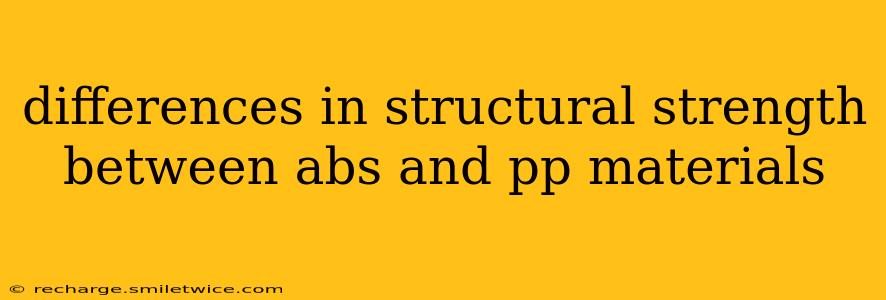Acrylonitrile Butadiene Styrene (ABS) and Polypropylene (PP) are both popular thermoplastic polymers used in a wide range of applications, from consumer goods to automotive parts. While both offer good strength and durability, they exhibit significant differences in their structural properties. Understanding these differences is crucial for selecting the right material for a specific application. This article will delve into the key distinctions in structural strength between ABS and PP, addressing common questions and providing valuable insights for engineers and designers.
What is the difference in tensile strength between ABS and PP?
Tensile strength, a measure of a material's ability to withstand pulling forces before breaking, is a key indicator of its structural integrity. Generally, ABS boasts a higher tensile strength than PP. However, the exact values vary greatly depending on the specific grade of the polymer, additives, and processing methods. While ABS typically ranges from 40 to 50 MPa, PP's tensile strength usually falls between 25 and 40 MPa. This means that, all other factors being equal, ABS is better able to resist stretching and tearing forces.
How does the impact resistance of ABS compare to PP?
Impact resistance, the ability of a material to withstand sudden shocks and blows without fracturing, is another critical structural property. In this regard, PP often shows superior impact strength compared to ABS. PP's highly crystalline structure and flexibility allow it to absorb energy more effectively during impact, leading to greater toughness and resistance to cracking. This makes PP particularly suitable for applications where impact resistance is paramount.
Which material, ABS or PP, has better flexural strength?
Flexural strength refers to a material's resistance to bending or flexing. While both ABS and PP exhibit reasonable flexural strength, ABS generally displays slightly better performance in this area. This advantage stems from ABS's higher tensile and yield strengths, allowing it to resist deformation under bending loads more effectively. However, the difference isn't always substantial and may depend on the specific grades of each material.
What are the differences in stiffness between ABS and PP?
Stiffness, or modulus of elasticity, represents a material's resistance to deformation under stress. PP tends to be stiffer than ABS. This means that PP will deform less under a given load compared to ABS. This higher stiffness makes PP suitable for applications requiring dimensional stability and resistance to bending or flexing, such as rigid containers or housings. Conversely, ABS's lower stiffness can be advantageous in applications requiring a degree of flexibility and impact absorption.
Is ABS or PP more resistant to creep?
Creep is the tendency of a material to slowly deform under sustained stress over time. Both ABS and PP exhibit creep, but the degree varies. Generally, PP demonstrates better creep resistance than ABS, especially at elevated temperatures. This makes PP a preferable choice for applications where long-term dimensional stability under load is crucial.
Which material is better for which applications based on strength?
The choice between ABS and PP depends heavily on the specific application requirements.
-
ABS excels in applications requiring: high tensile strength, good flexural strength, reasonable impact resistance, and ease of processing. Examples include housings for electronics, automotive parts, and appliance components.
-
PP shines in applications demanding: high impact resistance, excellent chemical resistance, good stiffness, and relatively low cost. This makes PP a popular choice for packaging, automotive interior parts, and medical devices.
Ultimately, the selection between ABS and PP involves careful consideration of multiple factors beyond just structural strength, including cost, chemical resistance, processability, and the specific environmental conditions the final product will encounter. Consulting material data sheets and conducting thorough testing are essential for making informed decisions.
